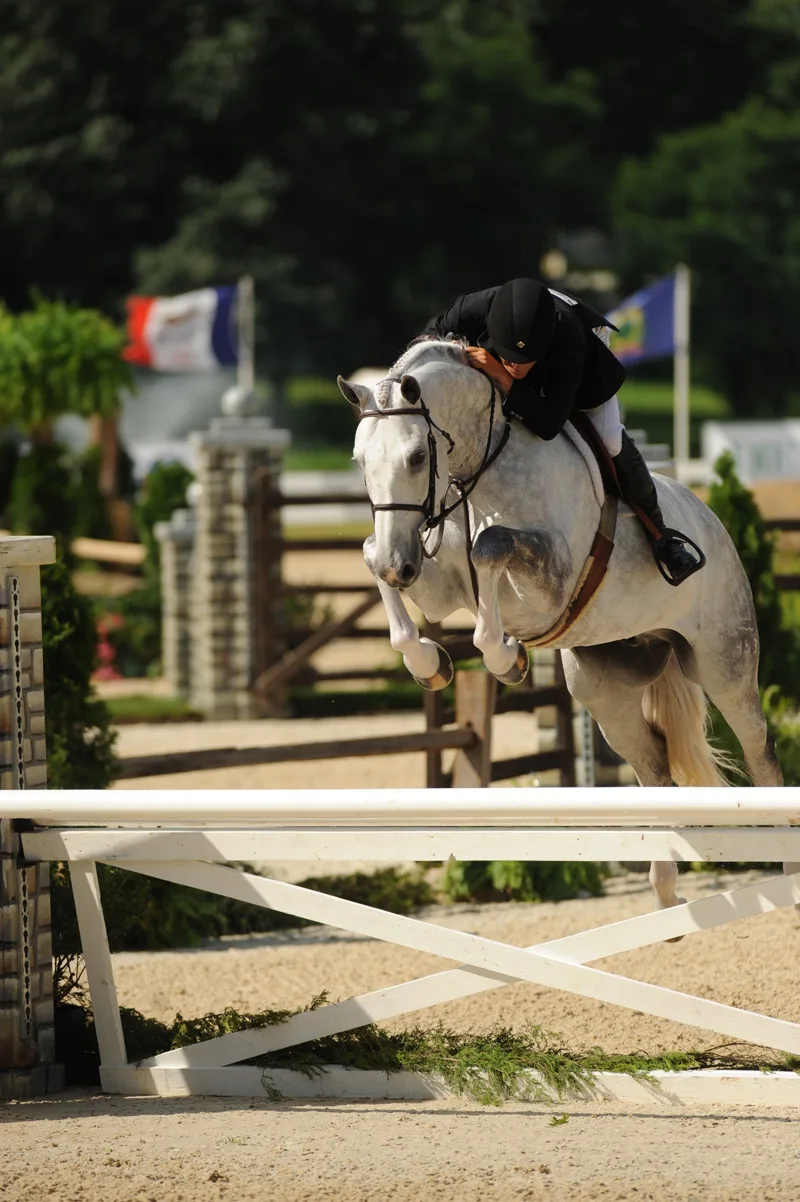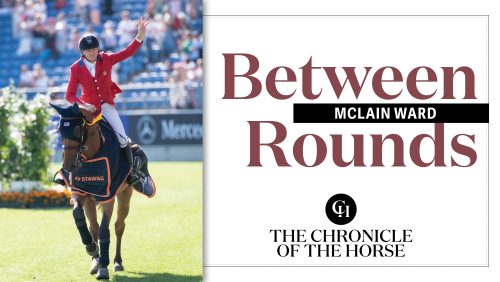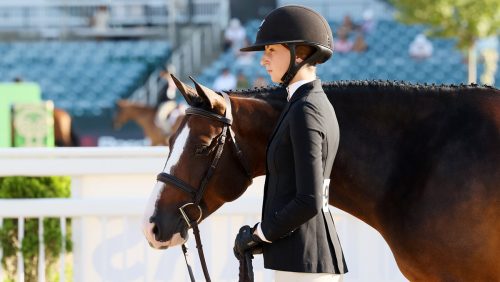Our columnist condemns the quest for comatose hunters, for the sake of safety, education and performance.
People should learn about horses, then learn to ride, then learn to compete. However, nowadays it seems this order has been reversed! People just want to show and win ribbons, and our sport has paid the price. Hunters jump lower and lower fences and are dumbed down to handle inexperienced riders.
I’d love to see the days of the comatose show hunter completely behind us, and I hope we’re going to see that happen sooner rather than later. There’s a feeling in our industry that continues to grow—trainers, owners, riders and judges are realizing that where we’ve ended up isn’t really where we wanted to go.
I’ve been involved in the sport for more than 30 years, from the days when our classic Thoroughbreds dominated the scene to today, when they are basically an anomaly in a show ring full of warmbloods.
I’d like to see the hunters return to more of the lighter types, with the Thoroughbred influencing their quality, jump and movement. About 20 years ago, hunters became completely different than they were in the mid-20th century, and that evolution has fundamentally changed how we do what we do today.
As a judge, I’m hoping to help guide our sport back to the days when hunters were rewarded for boldness and brilliance. During one judges’ clinic in Southern California, we had a lively classroom discussion about this topic. We want to encourage judges—new ones as well as experienced ones—to remember how important it is to reward expression. A major part of having a great round is when your horse is doing what he loves and expresses that sentiment.
As judges, we know when a horse that has been over-medicated or over-prepared comes into the ring. It’s actually the first thing we notice. Usually, they’re glassy-eyed or just not alert. Often, they’re slow to react to their surroundings or the aids, and that’s not safe for the horse or rider. I’m a professional. I know everyone’s under pressure to produce winners, but we owe it to our horses—and to the sport—to do a better job of training.
Maybe we need to take a step back and teach our clients to ride rather than having them simply learn to show. I see so many people who have no business showing because they don’t ride well enough yet. Our pros are under a lot of pressure to make money, make clients happy, and make them look good. It’s hard to tell clients that they’re not ready to go to a horse show. But as professionals, we owe it to our clients to educate them about the sport and horses, and we need to say up front that this is a sport that takes years to master.
That’s why riding a hunter or jumper is so incredibly rewarding—because it’s challenging, and it’s important to master the basics before you compete. Even the kindest horse can’t help a rider who just doesn’t know how to ride.
ADVERTISEMENT

Rumba put great effort and enthusiasm into his winning performance with John French at the 2009 ASG Software Solutions/USHJA International Hunter Derby Finals (Kentucky). “It really hit me how much that horse loved what he was doing,” recalls columnist Julie Winkel. Tricia Booker Photo
Enthusiasm Encouraged
Concurrently, we’ve seen an upswing in substances given to horses as quieting agents, including but not limited to magnesium sulfate, dexamethasone and Carolina Gold (GABA), which have been deemed prohibited substances by the U.S. Equestrian Federation and the Fédération Equestre Internationale.
There have been excellent articles written about the dangers of such drugs. Drugs are not the way to go, but I’m certainly not condoning the other primary way to quiet horses, “longeing ’til dead,” which is just as detrimental.
It’s a vicious cycle: Horses that get longed become too fit and have to be longed even more. Longing is hard on a horse’s tendons, ligaments and joints. So what is the answer?
It’s a combination of better horsemanship and fine-tuning our judging system. I’d love to see more horses out of their stalls, hand walking, hand grazing, allowed to mentally unwind instead of becoming physically exhausted. I know it’s easier said than done with the demands already imposed on our grooms, but altering the way we run our businesses is a big part of the solution. Let’s do the right thing, not the easy thing.
I don’t just sit in a judge’s box. I’m still in the thick of things with breeding and training young horses, taking clients to shows and giving lessons to novice children and timid adults. I understand the importance of safety and making sure horses are quiet and properly prepared for their jobs. But I have never condoned drug use. There are other ways!
Just because you’ve started a lot of young horses doesn’t mean that you have the key to success all mapped out. Once in a while, you’re going to get one that needs a different program, and you’ll do best by that horse to adapt to his needs. Yes, it may take more time, but by doing the right thing for each horse he’ll have a longer and more successful career.
In our U.S. Hunter Jumper Association Judges’ Clinics, we have ongoing discussions about altering the way we judge hunters. Trainers and professionals believe we want dead quiet, comatose horses when in fact that’s not the case. Having this discussion out in the open is a big step. It’s putting into writing what the judges are feeling and broadcasting our wishes.
Judges want to see more enthusiasm and liveliness in the hunters. But I also want to be clear that I’m not saying adult amateur hunters, for instance, should land off a jump and buck. That’s manners. They’re going to be penalized for bad manners! It’s important to remember that the amount and type of enthusiasm we see and score is all relative to the job the horse is doing. You’re always judging the class or division in front of you.
ADVERTISEMENT
In the high performance hunters, and especially in the derbies, we like to see more brilliance of pace and expression. For a junior or amateur-owner hunter, at this point in their careers we want to see a horse who still has enthusiasm for the job. We love to see a horse reading the jumps, looking for the next fence, listening to his rider, but looking through the bridle. So maybe he jumps big out of a line and shakes his head and plays on landing; that’s great. As horsemen, we accept that! If they love their job after years in the show ring, more power to them.
As you go down the levels, you’re looking for a horse who can take care of himself. You don’t want a comatose horse who can’t deal with inexperience of the rider. Safety becomes priority in these lower divisions.
On the other hand, manners are important. I’m a little harder on one that plays too hard and might unseat his adult or child rider. Their job is to cope with things that come up but still take care of their riders. Self-preservation can never be underrated either.
I believe consistent judging will change the goals we set for our horses. It’s all about continuing education for our judges, professionals, owners and riders.
At a past judge’s clinic, we watched a video of Rumba and John French winning the 2009 ASG Software Solutions/USHJA International Hunter Derby Finals (Kentucky). He put so much effort into every jump. There were probably three or four times where after the jump he shook his head with enthusiasm. That was something I’d noticed when I was judging the championship, and it really hit me how much that horse loved what he was doing. That outcome has to be our goal. The sport is about making our horses happy and not about making people look good.
At the end of the day, if we’re doing the right thing for the horses, then everything else is going to fall into place.
Julie Winkel has held her U.S. Equestrian Federation R-rated judging licenses in hunter, hunter breeding and equitation since 1984 and has presided over prestigious shows, such as Devon (Pennsylvania), all the fall indoor shows, the USHJA International Hunter Derby Championship (Kentucky), the USEF Pony Finals and the USEF/Sallie B. Wheeler National Hunter Breeding Championships.
Julie has also designed courses, trained and shown hunters and jumpers to the top levels, nationally and internationally, and continues to compete today. She’s a member of the USHJA Emerging Athletes Program Task Force and past member of the USHJA Trainer Certification Program Committee, the USHJA Judges Committee, the USEF and USHJA Equitation Committees, USHJA Trainer Symposium Task Force and the USHJA Zone 10 Jumper Committee.
In addition, Julie is a sought-after clinician. She wrote the monthly column “Conformation Clinic” for Practical Horseman for more than 10 years and contributes to USHJA In Stride, The Chronicle of the Horse, EquestrianCoach.com and many other publications. Her book “Judging Handbook for Trainers, Riders, Parents & Fellow Judges” is due out soon.
Julie owns and operates Maplewood Stables Inc., a 200-acre training, showing, sales and breeding facility in Reno. Maplewood stands three stallions, Cartouche Z, Good To Know and Osilvis.















